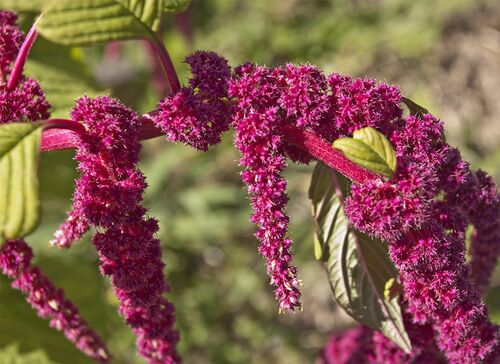Growing and Sowing of Love Lies Bleeding

The Love-Lies-Bleeding Amaranth (Amaranthus caudatus) is an annual ornamental plant known for its striking, long, hanging flower clusters that resemble thick “foxtail”.
Originally from South America, the plant can grow up to 1 meter (about 3 feet) tall. It has large leaves and blooms with long, gracefully drooping flower spikes, usually deep red, but sometimes green or cream-colored.
Love-Lies-Bleeding is a true eye-catcher in ornamental gardens and borders. In addition, it can be used as a cut flower or dried flower.
Sowing and growing Love Lies Bleeding
This large plant with beautiful, hanging flower plumes is a real eye-catcher in any garden. Originally from South America, this annual plant blooms from July to September.
The leaves are technically edible, although they are rarely used in cooking. The seeds are also edible and resemble quinoa seeds.
Sowing Love Lies Bleeding
Love-Lies-Bleeding can be sown indoors from April onwards. Outdoor sowing is possible from mid-May. Sow thinly and press the seeds lightly into the soil, do not cover them, as they need light to germinate. Water regularly, and when sowing indoors, place the seedlings in a warm and bright spot. Once the seedlings are large enough, you can transplant them into separate pots if needed. From mid-May, the plants can be moved outside, but make sure to harden them off first.
Buy Love Lies Bleeding Seeds Online >
Position and soil for Love Lies Bleeding
The ideal location for Love-Lies-Bleeding is a sunny, sheltered spot in the garden.
The soil should be well-drained and nutrient-rich. You can improve the soil by adding compost or fertilized garden soil if needed. To prevent the flower stems from bending or breaking, it may be necessary to provide support.
How to care for your Love Lies Bleeding plants
Water regularly, but avoid making the soil too wet, as this can cause the roots to rot. It's best to water around the base of the plant. Provide support to prevent the stems from bending or breaking. Fertilize the plant occasionally to encourage blooming.
You can remove spent flowers to keep the plant looking tidy. However, do note that faded flowers contain seeds. These can attract birds, or you can harvest the seeds yourself to sow the following year.
Are Love Lies Bleeding plants bee and/or butterfly friendly?
Love-Lies-Bleeding Amaranth is insect-friendly. The tiny flowers that make up the hanging plumes are rich in nectar and pollen, attracting bees, butterflies, and hoverflies.
Love Lies Bleeding in the vegetable garden
The leaves of Love-Lies-Bleeding Amaranth are edible and can be prepared like spinach. In addition, the flowers attract many pollinators, which is beneficial for other vegetable garden plants as well. The plant also contributes to biodiversity and adds a cheerful touch to the garden.
Is Love Lies Bleeding edible and/or medicinal?
Love-Lies-Bleeding Amaranth has medicinal uses, especially in the cultures where it originates, such as South America. The seeds are said to have a laxative effect, and the leaves are used to support digestion.
Please note, we at Dutch Garden Seeds do not give medical advice. Always ask a professional if and how the plant can be used medicinally.
Love Lies Bleeding Seeds in our collection
We have Love Lies Bleeding seeds in our range from the brand 'Buzzy Seeds'.
Tips for growing love lies bleeding
- prune the plant after it has finished flowering if you want to prevent it from self-seeding.
- The spent flowers are a welcome food source for garden birds.



